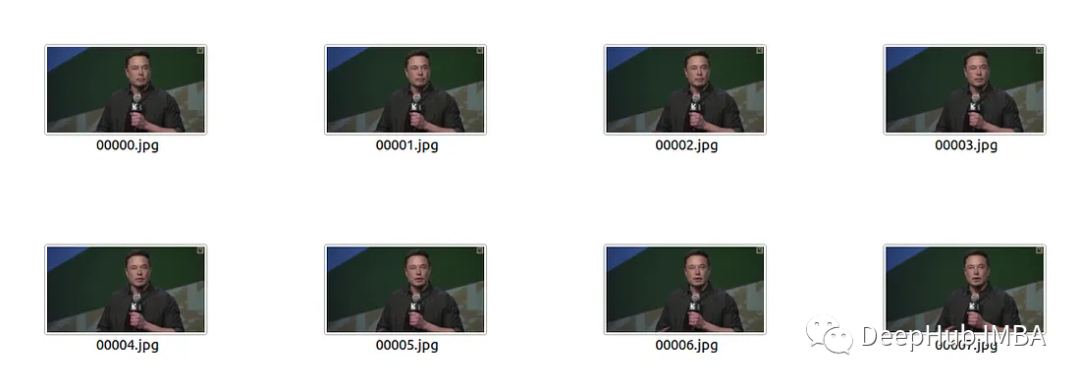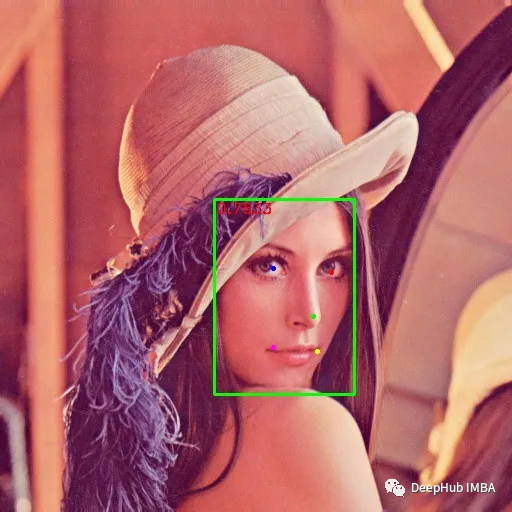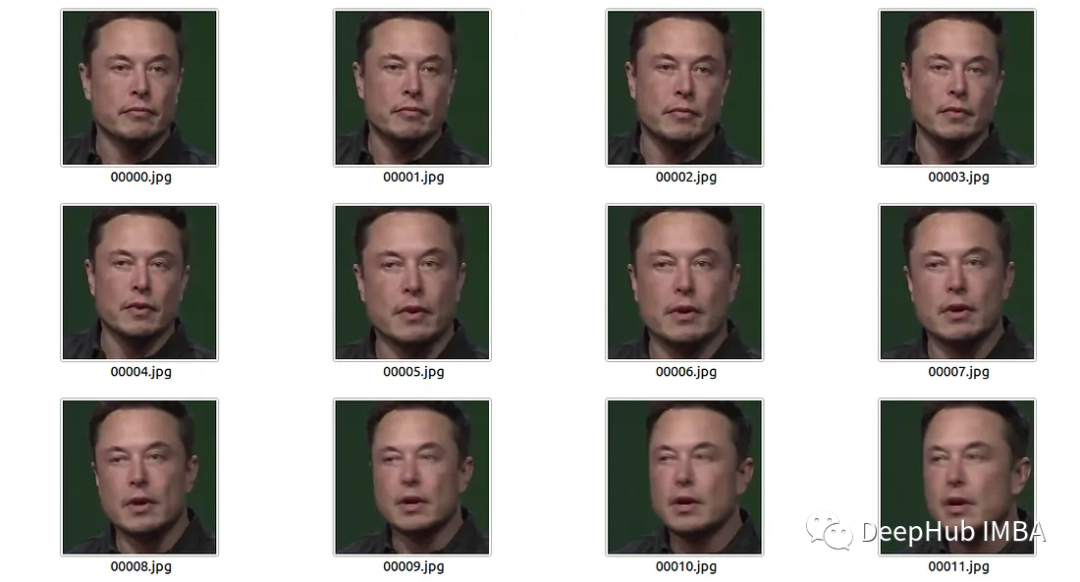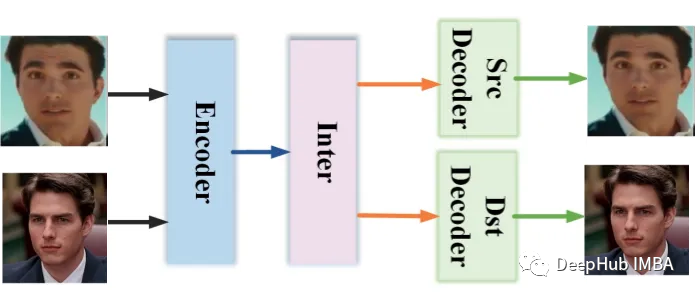使用Pytorch和OpenCV實現視頻人臉替換
“DeepFaceLab”項目已經發布了很長時間了,作為研究的目的,本文將介紹他的原理,并使用Pytorch和OpenCV創建一個簡化版本。
本文將分成3個部分,第一部分從兩個視頻中提取人臉并構建標準人臉數據集。第二部分使用數據集與神經網絡一起學習如何在潛在空間中表示人臉,并從該表示中重建人臉圖像。最后部分使用神經網絡在視頻的每一幀中創建與源視頻中相同但具有目標視頻中人物表情的人臉。然后將原人臉替換為假人臉,并將新幀保存為新的假視頻。
項目的基本結構(在第一次運行之前)如下所示
├── face_masking.py
├── main.py
├── face_extraction_tools.py
├── quick96.py
├── merge_frame_to_fake_video.py
├── data
│ ├── data_dst.mp4
│ ├── data_src.mp4main.py是主腳本,data文件夾包含程序需要的的data_dst.mp4和data_src.mp4文件。
提取和對齊-構建數據集
在第一部分中,我們主要介紹face_extraction_tools.py文件中的代碼。
因為第一步是從視頻中提取幀,所以需要構建一個將幀保存為JPEG圖像的函數。這個函數接受一個視頻的路徑和另一個輸出文件夾的路徑。
def extract_frames_from_video(video_path: Union[str, Path], output_folder: Union[str, Path], frames_to_skip: int=0) -> None:
"""
Extract frame from video as a JPG images.
Args:
video_path (str | Path): the path to the input video from it the frame will be extracted
output_folder (str | Path): the folder where the frames will be saved
frames_to_skip (int): how many frames to skip after a frame which is saved. 0 will save all the frames.
If, for example, this value is 2, the first frame will be saved, then frame 2 and 3 will be skipped,
the 4th frame will be saved, and so on.
Returns:
"""
video_path = Path(video_path)
output_folder = Path(output_folder)
if not video_path.exists():
raise ValueError(f'The path to the video file {video_path.absolute()} is not exist')
if not output_folder.exists():
output_folder.mkdir(parents=True)
video_capture = cv2.VideoCapture(str(video_path))
extract_frame_counter = 0
saved_frame_counter = 0
while True:
ret, frame = video_capture.read()
if not ret:
break
if extract_frame_counter % (frames_to_skip + 1) == 0:
cv2.imwrite(str(output_folder / f'{saved_frame_counter:05d}.jpg'), frame, [cv2.IMWRITE_JPEG_QUALITY, 90])
saved_frame_counter += 1
extract_frame_counter += 1
print(f'{saved_frame_counter} of {extract_frame_counter} frames saved')函數首先檢查視頻文件是否存在,以及輸出文件夾是否存在,如果不存在則自動創建。然后使用OpenCV 的videoccapture類來創建一個對象來讀取視頻,然后逐幀保存為輸出文件夾中的JPEG文件。也可以根據frames_to_skip參數跳過幀。

然后就是需要構建人臉提取器。該工具應該能夠檢測圖像中的人臉,提取并對齊它。構建這樣一個工具的最佳方法是創建一個FaceExtractor類,其中包含檢測、提取和對齊的方法。
對于檢測部分,我們將使用帶有OpenCV的YuNet。YuNet是一個快速準確的基于cnn的人臉檢測器,可以由OpenCV中的FaceDetectorYN類使用。要創建這樣一個FaceDetectorYN對象,我們需要一個帶有權重的ONNX文件。該文件可以在OpenCV Zoo中找到,當前版本名為“face_detection_yunet_2023mar.onnx”。
我們的init()方法如下:
def __init__(self, image_size):
"""
Create a YuNet face detector to get face from image of size 'image_size'. The YuNet model
will be downloaded from opencv zoo, if it's not already exist.
Args:
image_size (tuple): a tuple of (width: int, height: int) of the image to be analyzed
"""
detection_model_path = Path('models/face_detection_yunet_2023mar.onnx')
if not detection_model_path.exists():
detection_model_path.parent.mkdir(parents=True, exist_ok=True)
url = "https://github.com/opencv/opencv_zoo/blob/main/models/face_detection_yunet/face_detection_yunet_2023mar.onnx"
print('Downloading face detection model...')
filename, headers = urlretrieve(url, filename=str(detection_model_path))
print('Download finish!')
self.detector = cv2.FaceDetectorYN.create(str(detection_model_path), "", image_size)函數首先檢查權重文件是否存在,如果不存在,則從web下載。然后使用權重文件和要分析的圖像大小創建FaceDetectorYN對象。檢測方法采用YuNet檢測方法在圖像中尋找人臉
def detect(self, image):
ret, faces = self.detector.detect(image)
return ret, facesYuNet的輸出是一個大小為[num_faces, 15]的2D數組,包含以下信息:
- 0-1:邊界框左上角的x, y
- 2-3:邊框的寬度、高度
- 4-5:右眼的x, y(樣圖中藍點)
- 6-7:左眼x, y(樣圖中紅點)
- 8-9:鼻尖x, y(示例圖中綠色點)
- 10-11:嘴巴右角的x, y(樣例圖像中的粉色點)
- 12-13:嘴角左角x, y(樣例圖中黃色點)
- 14:面部評分

現在已經有了臉部位置數據,我們可以用它來獲得臉部的對齊圖像。這里主要利用眼睛位置的信息。我們希望眼睛在對齊后的圖像中處于相同的水平(相同的y坐標)。
@staticmethod
def align(image, face, desired_face_width=256, left_eye_desired_coordinate=np.array((0.37, 0.37))):
"""
Align the face so the eyes will be at the same level
Args:
image (np.ndarray): image with face
face (np.ndarray): face coordinates from the detection step
desired_face_width (int): the final width of the aligned face image
left_eye_desired_coordinate (np.ndarray): a length 2 array of values between
0 and 1 where the left eye should be in the aligned image
Returns:
(np.ndarray): aligned face image
"""
desired_face_height = desired_face_width
right_eye_desired_coordinate = np.array((1 - left_eye_desired_coordinate[0], left_eye_desired_coordinate[1]))
# get coordinate of the center of the eyes in the image
right_eye = face[4:6]
left_eye = face[6:8]
# compute the angle of the right eye relative to the left eye
dist_eyes_x = right_eye[0] - left_eye[0]
dist_eyes_y = right_eye[1] - left_eye[1]
dist_between_eyes = np.sqrt(dist_eyes_x ** 2 + dist_eyes_y ** 2)
angles_between_eyes = np.rad2deg(np.arctan2(dist_eyes_y, dist_eyes_x) - np.pi)
eyes_center = (left_eye + right_eye) // 2
desired_dist_between_eyes = desired_face_width * (
right_eye_desired_coordinate[0] - left_eye_desired_coordinate[0])
scale = desired_dist_between_eyes / dist_between_eyes
M = cv2.getRotationMatrix2D(eyes_center, angles_between_eyes, scale)
M[0, 2] += 0.5 * desired_face_width - eyes_center[0]
M[1, 2] += left_eye_desired_coordinate[1] * desired_face_height - eyes_center[1]
face_aligned = cv2.warpAffine(image, M, (desired_face_width, desired_face_height), flags=cv2.INTER_CUBIC)
return face_aligned這個方法獲取單張人臉的圖像和信息,輸出圖像的寬度和期望的左眼相對位置。我們假設輸出圖像是平方的,并且右眼的期望位置具有相同的y位置和x位置的1 - left_eye_x。計算兩眼之間的距離和角度,以及兩眼之間的中心點。
最后一個方法是extract方法,它類似于align方法,但沒有轉換,它也返回圖像中人臉的邊界框。
def extract_and_align_face_from_image(input_dir: Union[str, Path], desired_face_width: int=256) -> None:
"""
Extract the face from an image, align it and save to a directory inside in the input directory
Args:
input_dir (str|Path): path to the directory contains the images extracted from a video
desired_face_width (int): the width of the aligned imaged in pixels
Returns:
"""
input_dir = Path(input_dir)
output_dir = input_dir / 'aligned'
if output_dir.exists():
rmtree(output_dir)
output_dir.mkdir()
image = cv2.imread(str(input_dir / '00000.jpg'))
image_height = image.shape[0]
image_width = image.shape[1]
detector = FaceExtractor((image_width, image_height))
for image_path in tqdm(list(input_dir.glob('*.jpg'))):
image = cv2.imread(str(image_path))
ret, faces = detector.detect(image)
if faces is None:
continue
face_aligned = detector.align(image, faces[0, :], desired_face_width)
cv2.imwrite(str(output_dir / f'{image_path.name}'), face_aligned, [cv2.IMWRITE_JPEG_QUALITY, 90])
訓練
對于網絡,我們將使用AutoEncoder。在AutoEncoder中,有兩個主要組件——編碼器和解碼器。編碼器獲取原始圖像并找到它的潛在表示,解碼器利用潛在表示重構原始圖像。
對于我們的任務,要訓練一個編碼器來找到一個潛在的人臉表示和兩個解碼器——一個可以重建源人臉,另一個可以重建目標人臉。

在這三個組件被訓練之后,我們回到最初的目標:創建一個源面部但具有目標表情的圖像。也就是說使用解碼器A和人臉B的圖像。

面孔的潛在空間保留了面部的主要特征,如位置、方向和表情。解碼器獲取這些編碼信息并學習如何構建全臉圖像。由于解碼器A只知道如何構造A類型的臉,因此它從編碼器中獲取圖像B的特征并從中構造A類型的圖像。
在本文中,我們將使用來自原始DeepFaceLab項目的Quick96架構的一個小修改版本。

模型的全部細節可以在quick96.py文件中。
在我們訓練模型之前,還需要處理數據。為了使模型具有魯棒性并避免過擬合,我們還需要在原始人臉圖像上應用兩種類型的增強。第一個是一般的轉換,包括旋轉,縮放,在x和y方向上的平移,以及水平翻轉。對于每個轉換,我們為參數或概率定義一個范圍(例如,我們可以用來旋轉的角度范圍),然后從范圍中選擇一個隨機值來應用于圖像。
random_transform_args = {
'rotation_range': 10,
'zoom_range': 0.05,
'shift_range': 0.05,
'random_flip': 0.5,
}
def random_transform(image, rotation_range, zoom_range, shift_range, random_flip):
"""
Make a random transformation for an image, including rotation, zoom, shift and flip.
Args:
image (np.array): an image to be transformed
rotation_range (float): the range of possible angles to rotate - [-rotation_range, rotation_range]
zoom_range (float): range of possible scales - [1 - zoom_range, 1 + zoom_range]
shift_range (float): the percent of translation for x and y
random_flip (float): the probability of horizontal flip
Returns:
(np.array): transformed image
"""
h, w = image.shape[0:2]
rotation = np.random.uniform(-rotation_range, rotation_range)
scale = np.random.uniform(1 - zoom_range, 1 + zoom_range)
tx = np.random.uniform(-shift_range, shift_range) * w
ty = np.random.uniform(-shift_range, shift_range) * h
mat = cv2.getRotationMatrix2D((w // 2, h // 2), rotation, scale)
mat[:, 2] += (tx, ty)
result = cv2.warpAffine(image, mat, (w, h), borderMode=cv2.BORDER_REPLICATE)
if np.random.random() < random_flip:
result = result[:, ::-1]
return result第2個是通過使用帶噪聲的插值圖產生的失真。這種扭曲將迫使模型理解人臉的關鍵特征,并使其更加一般化。
def random_warp(image):
"""
Create a distorted face image and a target undistorted image
Args:
image (np.array): image to warp
Returns:
(np.array): warped version of the image
(np.array): target image to construct from the warped version
"""
h, w = image.shape[:2]
# build coordinate map to wrap the image according to
range_ = np.linspace(h / 2 - h * 0.4, h / 2 + h * 0.4, 5)
mapx = np.broadcast_to(range_, (5, 5))
mapy = mapx.T
# add noise to get a distortion of the face while warp the image
mapx = mapx + np.random.normal(size=(5, 5), scale=5*h/256)
mapy = mapy + np.random.normal(size=(5, 5), scale=5*h/256)
# get interpolation map for the center of the face with size of (96, 96)
interp_mapx = cv2.resize(mapx, (int(w / 2 * (1 + 0.25)) , int(h / 2 * (1 + 0.25))))[int(w/2 * 0.25/2):int(w / 2 * (1 + 0.25) - w/2 * 0.25/2), int(w/2 * 0.25/2):int(w / 2 * (1 + 0.25) - w/2 * 0.25/2)].astype('float32')
interp_mapy = cv2.resize(mapy, (int(w / 2 * (1 + 0.25)) , int(h / 2 * (1 + 0.25))))[int(w/2 * 0.25/2):int(w / 2 * (1 + 0.25) - w/2 * 0.25/2), int(w/2 * 0.25/2):int(w / 2 * (1 + 0.25) - w/2 * 0.25/2)].astype('float32')
# remap the face image according to the interpolation map to get warp version
warped_image = cv2.remap(image, interp_mapx, interp_mapy, cv2.INTER_LINEAR)
# create the target (undistorted) image
# find a transformation to go from the source coordinates to the destination coordinate
src_points = np.stack([mapx.ravel(), mapy.ravel()], axis=-1)
dst_points = np.mgrid[0:w//2+1:w//8, 0:h//2+1:h//8].T.reshape(-1, 2)
# We want to find a similarity matrix (scale rotation and translation) between the
# source and destination points. The matrix should have the structure
# [[a, -b, c],
# [b, a, d]]
# so we can construct unknown vector [a, b, c, d] and solve for it using least
# squares with the source and destination x and y points.
A = np.zeros((2 * src_points.shape[0], 2))
A[0::2, :] = src_points # [x, y]
A[0::2, 1] = -A[0::2, 1] # [x, -y]
A[1::2, :] = src_points[:, ::-1] # [y, x]
A = np.hstack((A, np.tile(np.eye(2), (src_points.shape[0], 1)))) # [x, -y, 1, 0] for x coordinate and [y, x, 0 ,1] for y coordinate
b = dst_points.flatten() # arrange as [x0, y0, x1, y1, ..., xN, yN]
similarity_mat = np.linalg.lstsq(A, b, rcond=None)[0] # get the similarity matrix elements as vector [a, b, c, d]
# construct the similarity matrix from the result vector of the least squares
similarity_mat = np.array([[similarity_mat[0], -similarity_mat[1], similarity_mat[2]],
[similarity_mat[1], similarity_mat[0], similarity_mat[3]]])
# use the similarity matrix to construct the target image using affine transformation
target_image = cv2.warpAffine(image, similarity_mat, (w // 2, h // 2))
return warped_image, target_image這個函數有兩個部分,我們首先在面部周圍的區域創建圖像的坐標圖。有一個x坐標的映射和一個y坐標的映射。mapx和mapy變量中的值是以像素為單位的坐標。然后在圖像上添加一些噪聲,使坐標在隨機方向上移動。我們添加的噪聲,得到了一個扭曲的坐標(像素在隨機方向上移動一點)。然后裁剪了插值后的貼圖,使其包含臉部的中心,大小為96x96像素。現在我們可以使用扭曲的映射來重新映射圖像,得到一個新的扭曲的圖像。
在第二部分創建未扭曲的圖像,這是模型應該從扭曲的圖像中創建的目標圖像。使用噪聲作為源坐標,并為目標圖像定義一組目標坐標。然后我們使用最小二乘法找到一個相似變換矩陣(尺度旋轉和平移),將其從源坐標映射到目標坐標,并將其應用于圖像以獲得目標圖像。

然后就可以創建一個Dataset類來處理數據了。FaceData類非常簡單。它獲取包含src和dst文件夾的文件夾的路徑,其中包含我們在前一部分中創建的數據,并返回大小為(2 * 96,2 * 96)歸一化為1的隨機源和目標圖像。我們的網絡將得到的是一個經過變換和扭曲的圖像,以及源臉和目標臉的目標圖像。所以還需要實現了一個collate_fn
def collate_fn(self, batch):
"""
Collate function to arrange the data returns from a batch. The batch returns a list
of tuples contains pairs of source and destination images, which is the input of this
function, and the function returns a tuple with 4 4D tensors of the warp and target
images for the source and destination
Args:
batch (list): a list of tuples contains pairs of source and destination images
as numpy array
Returns:
(torch.Tensor): a 4D tensor of the wrap version of the source images
(torch.Tensor): a 4D tensor of the target source images
(torch.Tensor): a 4D tensor of the wrap version of the destination images
(torch.Tensor): a 4D tensor of the target destination images
"""
images_src, images_dst = list(zip(*batch)) # convert list of tuples with pairs of images into tuples of source and destination images
warp_image_src, target_image_src = get_training_data(images_src, len(images_src))
warp_image_src = torch.tensor(warp_image_src, dtype=torch.float32).permute(0, 3, 1, 2).to(device)
target_image_src = torch.tensor(target_image_src, dtype=torch.float32).permute(0, 3, 1, 2).to(device)
warp_image_dst, target_image_dst = get_training_data(images_dst, len(images_dst))
warp_image_dst = torch.tensor(warp_image_dst, dtype=torch.float32).permute(0, 3, 1, 2).to(device)
target_image_dst = torch.tensor(target_image_dst, dtype=torch.float32).permute(0, 3, 1, 2).to(device)
return warp_image_src, target_image_src, warp_image_dst, target_image_dst當我們從Dataloader對象獲取數據時,它將返回一個元組,其中包含來自FaceData對象的源圖像和目標圖像對。collate_fn接受這個結果,并對圖像進行變換和失真,得到目標圖像,并為扭曲的源圖像、目標源圖像、扭曲的目標圖像和目標目標圖像返回四個4D張量。
訓練使用的損失函數是MSE (L2)損失和DSSIM的組合

訓練的指標和結果如上圖所示
生成視頻
在最后一步就是創建視頻。處理此任務的函數稱為merge_frame_to_fake_video.py。我們使用MediaPipe創建了facemask類。
當初始化facemask對象時,初始化MediaPipe人臉檢測器。
class FaceMasking:
def __init__(self):
landmarks_model_path = Path('models/face_landmarker.task')
if not landmarks_model_path.exists():
landmarks_model_path.parent.mkdir(parents=True, exist_ok=True)
url = "https://storage.googleapis.com/mediapipe-models/face_landmarker/face_landmarker/float16/latest/face_landmarker.task"
print('Downloading face landmarks model...')
filename, headers = urlretrieve(url, filename=str(landmarks_model_path))
print('Download finish!')
base_options = python_mp.BaseOptions(model_asset_path=str(landmarks_model_path))
options = vision.FaceLandmarkerOptions(base_options=base_options,
output_face_blendshapes=False,
output_facial_transformation_matrixes=False,
num_faces=1)
self.detector = vision.FaceLandmarker.create_from_options(options)這個類也有一個從人臉圖像中獲取掩碼的方法:
def get_mask(self, image):
"""
return uint8 mask of the face in image
Args:
image (np.ndarray): RGB image with single face
Returns:
(np.ndarray): single channel uint8 mask of the face
"""
im_mp = mp.Image(image_format=mp.ImageFormat.SRGB, data=image.astype(np.uint8).copy())
detection_result = self.detector.detect(im_mp)
x = np.array([landmark.x * image.shape[1] for landmark in detection_result.face_landmarks[0]], dtype=np.float32)
y = np.array([landmark.y * image.shape[0] for landmark in detection_result.face_landmarks[0]], dtype=np.float32)
hull = np.round(np.squeeze(cv2.convexHull(np.column_stack((x, y))))).astype(np.int32)
mask = np.zeros(image.shape[:2], dtype=np.uint8)
mask = cv2.fillConvexPoly(mask, hull, 255)
kernel = np.ones((7, 7), np.uint8)
mask = cv2.erode(mask, kernel)
return mask該函數首先將輸入圖像轉換為MediaPipe圖像結構,然后使用人臉檢測器查找人臉。然后使用OpenCV找到點的凸包,并使用OpenCV的fillConvexPoly函數填充凸包的區域,從而得到一個二進制掩碼。最后,我們應用侵蝕操作來縮小遮蔽。
def get_mask(self, image):
"""
return uint8 mask of the face in image
Args:
image (np.ndarray): RGB image with single face
Returns:
(np.ndarray): single channel uint8 mask of the face
"""
im_mp = mp.Image(image_format=mp.ImageFormat.SRGB, data=image.astype(np.uint8).copy())
detection_result = self.detector.detect(im_mp)
x = np.array([landmark.x * image.shape[1] for landmark in detection_result.face_landmarks[0]], dtype=np.float32)
y = np.array([landmark.y * image.shape[0] for landmark in detection_result.face_landmarks[0]], dtype=np.float32)
hull = np.round(np.squeeze(cv2.convexHull(np.column_stack((x, y))))).astype(np.int32)
mask = np.zeros(image.shape[:2], dtype=np.uint8)
mask = cv2.fillConvexPoly(mask, hull, 255)
kernel = np.ones((7, 7), np.uint8)
mask = cv2.erode(mask, kernel)
return maskmerge_frame_to_fake_video函數就是將上面所有的步驟整合,創建一個新的視頻對象,一個FaceExtracot對象,一個facemask對象,創建神經網絡組件,并加載它們的權重。
def merge_frames_to_fake_video(dst_frames_path, model_name='Quick96', saved_models_dir='saved_model'):
model_path = Path(saved_models_dir) / f'{model_name}.pth'
dst_frames_path = Path(dst_frames_path)
image = Image.open(next(dst_frames_path.glob('*.jpg')))
image_size = image.size
result_video = cv2.VideoWriter(str(dst_frames_path.parent / 'fake.mp4'), cv2.VideoWriter_fourcc(*'MJPG'), 30, image.size)
face_extractor = FaceExtractor(image_size)
face_masker = FaceMasking()
encoder = Encoder().to(device)
inter = Inter().to(device)
decoder = Decoder().to(device)
saved_model = torch.load(model_path)
encoder.load_state_dict(saved_model['encoder'])
inter.load_state_dict(saved_model['inter'])
decoder.load_state_dict(saved_model['decoder_src'])
model = torch.nn.Sequential(encoder, inter, decoder)然后針對目標視頻中的所有幀,找到臉。如果沒有人臉就把畫面寫入視頻。如果有人臉,將其提取出來,轉換為網絡的適當輸入,并生成新的人臉。
對原人臉和新人臉進行遮蔽,利用遮蔽圖像上的矩量找到原人臉的中心。使用無縫克隆,以逼真的方式將新臉代替原來的臉(例如,改變假臉的膚色,以適應原來的臉皮膚)。最后將結果作為一個新的幀放回原始幀,并將其寫入視頻文件。
frames_list = sorted(dst_frames_path.glob('*.jpg'))
for ii, frame_path in enumerate(frames_list, 1):
print(f'Working om {ii}/{len(frames_list)}')
frame = cv2.imread(str(frame_path))
retval, face = face_extractor.detect(frame)
if face is None:
result_video.write(frame)
continue
face_image, face = face_extractor.extract(frame, face[0])
face_image = face_image[..., ::-1].copy()
face_image_cropped = cv2.resize(face_image, (96, 96)) #face_image_resized[96//2:96+96//2, 96//2:96+96//2]
face_image_cropped_torch = torch.tensor(face_image_cropped / 255., dtype=torch.float32).permute(2, 0, 1).unsqueeze(0).to(device)
generated_face_torch = model(face_image_cropped_torch)
generated_face = (generated_face_torch.squeeze().permute(1,2,0).detach().cpu().numpy() * 255).astype(np.uint8)
mask_origin = face_masker.get_mask(face_image_cropped)
mask_fake = face_masker.get_mask(generated_face)
origin_moments = cv2.moments(mask_origin)
cx = np.round(origin_moments['m10'] / origin_moments['m00']).astype(int)
cy = np.round(origin_moments['m01'] / origin_moments['m00']).astype(int)
try:
output_face = cv2.seamlessClone(generated_face, face_image_cropped, mask_fake, (cx, cy), cv2.NORMAL_CLONE)
except:
print('Skip')
continue
fake_face_image = cv2.resize(output_face, (face_image.shape[1], face_image.shape[0]))
fake_face_image = fake_face_image[..., ::-1] # change to BGR
frame[face[1]:face[1]+face[3], face[0]:face[0]+face[2]] = fake_face_image
result_video.write(frame)
result_video.release()一幀的結果是這樣的

模型并不完美,面部的某些角度,特別是側面視圖,會導致圖像不那么好,但總體效果不錯。
整合
為了運行整個過程,還需要創建一個主腳本。
from pathlib import Path
import face_extraction_tools as fet
import quick96 as q96
from merge_frame_to_fake_video import merge_frames_to_fake_video
##### user parameters #####
# True for executing the step
extract_and_align_src = True
extract_and_align_dst = True
train = True
eval = False
model_name = 'Quick96' # use this name to save and load the model
new_model = False # True for creating a new model even if a model with the same name already exists
##### end of user parameters #####
# the path for the videos to process
data_root = Path('./data')
src_video_path = data_root / 'data_src.mp4'
dst_video_path = data_root / 'data_dst.mp4'
# path to folders where the intermediate product will be saved
src_processing_folder = data_root / 'src'
dst_processing_folder = data_root / 'dst'
# step 1: extract the frames from the videos
if extract_and_align_src:
fet.extract_frames_from_video(video_path=src_video_path, output_folder=src_processing_folder, frames_to_skip=0)
if extract_and_align_dst:
fet.extract_frames_from_video(video_path=dst_video_path, output_folder=dst_processing_folder, frames_to_skip=0)
# step 2: extract and align face from frames
if extract_and_align_src:
fet.extract_and_align_face_from_image(input_dir=src_processing_folder, desired_face_width=256)
if extract_and_align_dst:
fet.extract_and_align_face_from_image(input_dir=dst_processing_folder, desired_face_width=256)
# step 3: train the model
if train:
q96.train(str(data_root), model_name, new_model, saved_models_dir='saved_model')
# step 4: create the fake video
if eval:
merge_frames_to_fake_video(dst_processing_folder, model_name, saved_models_dir='saved_model')總結 在這篇文章中,我們介紹了DeepFaceLab的運行流程,并使用我們自己的方法實現了該過程。我們首先從視頻中提取幀,然后從幀中提取人臉并對齊它們以創建一個數據庫。使用神經網絡來學習如何在潛在空間中表示人臉以及如何重建人臉。遍歷了目標視頻的幀,找到了人臉并替換,這就是這個項目的完整流程。
本文只做學習研究,實際項目請參見:







































